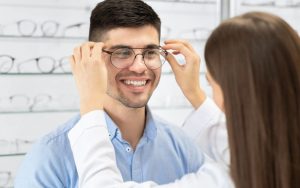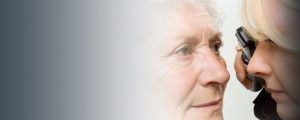Annual eye exams help to ensure that you are seeing clearly, but also facilitate regular monitoring of your eye health.
Most patients enjoy their visit to the eye doctor, there are always new frames to look at and the staff and eye doctors are usually a friendly bunch working in a relaxed office.
Are eye exams important?
Yes! Many eye conditions, in their early stages, have no obvious signs or symptoms, so the annual exam is often the only way to detect eye conditions early.
This can leave people believing there is nothing wrong with their eyes. However, since there are no signs or symptoms, regular comprehensive eye exams are key to maintaining good vision and healthy eyes.
A yearly eye exam allows your eye doctor to monitor your vision and eye health over the long-term, and can help detect signs of medical conditions, including diabetes and high blood pressure.
When was the last time you went for an eye exam? Schedule an exam today!
SEE RELATED: What to Do Before an Eye Exam?
What does an eye exam include?
Some tests that your eye doctor may perform during your eye exam include:
- Preliminary Tests – this may include evaluations of peripheral vision, depth perception, color vision, eye muscle movements, and how your pupils react to light.
- Visual Acuity – this evaluates how clearly each eye sees. A reading chart is frequently used during this test. Visual acuity is measured as ‘20/X’, e.g. 20/30 or 20/40. 20/20 is considered perfect vision, but some people have such clear sight, their visual acuities are recorded at 20/15 or even 20/10.
- Optical prescription – the eye doctor will provide an evaluation of your optical prescription, to see if there are any updates that can deliver clearer eyesight.
- Eye Focusing – this test determines how well your eyes move, focus, and work together. Your doctor will be able to see problems that prevent your eyes from focusing effectively or working well together.
- Digital Retinal Image – this test is a digital recording of retinal health achieved by taking an image of the retina. These photographs can be used for accurate diagnosis and stored and used to compare to any future images.
- Eye pressure test (IOP) – this is usually done with a puff of air. Sometimes the eye doctor will gently touch the front surface of your eye with a device that glows with a blue light. IOP is vitally important for eye conditions including glaucoma and corneal disease.
- Slit-lamp – this exam gives your eye doctor a magnified view of the many different structures at the front of the eye and inside, such as the cornea, pupil, iris, tear ducts, lens and retina. The area surrounding the eyes can also be examined, such as the eyelids and the adjacent periorbital skin.
- Ophthalmoscopy – this test uses a bright hand-held light to assess the health of the back of the eyes, and can detect cataracts, retinal detachment, glaucoma, and macular degeneration.
Importance of eye exams
A yearly eye exam is recommended for everyone, especially those over the age of 50, to ensure you have clear vision as well as good eye health.
Don’t wait until you can’t read a street sign a few feet away or the computer screen seems fuzzy.
LEARN MORE: Guide to Eye Exams
Schedule an eye exam to help keep you and your eyes healthy.









